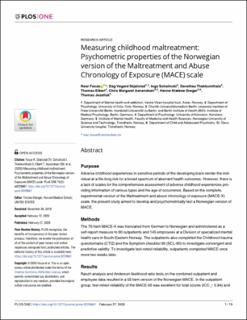| dc.contributor.author | Fosse, Roar | |
| dc.contributor.author | Skjelstad, Dag Vegard | |
| dc.contributor.author | Schalinski, Inga | |
| dc.contributor.author | Thekkumthala, Dorothea | |
| dc.contributor.author | Elbert, Thomas | |
| dc.contributor.author | Aanondsen, Chris Margaret | |
| dc.contributor.author | Greger, Hanne Klæboe | |
| dc.contributor.author | Jozefiak, Thomas | |
| dc.date.accessioned | 2021-02-17T14:01:55Z | |
| dc.date.available | 2021-02-17T14:01:55Z | |
| dc.date.created | 2020-06-30T11:19:04Z | |
| dc.date.issued | 2020 | |
| dc.identifier.citation | PLOS ONE. 2020, 15 (2), . | en_US |
| dc.identifier.issn | 1932-6203 | |
| dc.identifier.uri | https://hdl.handle.net/11250/2728716 | |
| dc.description.abstract | Purpose
Adverse childhood experiences in sensitive periods of the developing brain render the individual at a life-long risk for a broad spectrum of aberrant health outcomes. However, there is a lack of scales for the comprehensive assessment of adverse childhood experiences providing information of various types and the age of occurrence. Based on the complete, experimental version of the Maltreatment and abuse chronology of exposure (MACE-X) scale, the present study aimed to develop and psychometrically test a Norwegian version of MACE.
Methods
The 75-item MACE-X was translated from German to Norwegian and administered as a self-report measure to 90 outpatients and 145 employees at a Division of specialized mental health care in South-Eastern Norway. The outpatients also completed the Childhood trauma questionnaire (CTQ) and the Symptom checklist 90 (SCL-90) to investigate convergent and predictive validity. To investigate test-retest reliability, outpatients completed MACE once more two weeks later.
Results
Rasch analysis and Anderson likelihood ratio tests on the combined outpatient and employee data resulted in a 55 item version of the Norwegian MACE. In the outpatient group, test-retest reliability of the MACE-55 was excellent for total scores (ICC ≥ 0.94) and good to excellent for 10 subscale scores (ICC ≥ 0.82). Convergent validity with the CTQ was moderate to high for both total scores (0.63 ≥ r ≥ 0.86) and subscale scores (0.56 ≥ r ≥ 0.82). As compared to CTQ total scores, a MACE total score that combined severity and duration of exposure was numerically more strongly associated with overall psychiatric symptoms and each of nine symptom domains on the SCL-90.
Conclusions
The newly developed Norwegian MACE comprehensively assesses past exposure to adverse childhood experiences with high psychometric properties. This scale is a useful tool for research questions addressing sensitive periods for childhood adversities and associated health phenotypes. | en_US |
| dc.language.iso | eng | en_US |
| dc.publisher | PLOS, Public Library of Science | en_US |
| dc.rights | Navngivelse 4.0 Internasjonal | * |
| dc.rights.uri | http://creativecommons.org/licenses/by/4.0/deed.no | * |
| dc.title | Measuring childhood maltreatment: Psychometric properties of the Norwegian version of the Maltreatment and Abuse Chronology of Exposure (MACE) scale | en_US |
| dc.type | Peer reviewed | en_US |
| dc.type | Journal article | en_US |
| dc.description.version | publishedVersion | en_US |
| dc.source.pagenumber | 19 | en_US |
| dc.source.volume | 15 | en_US |
| dc.source.journal | PLOS ONE | en_US |
| dc.source.issue | 2 | en_US |
| dc.identifier.doi | 10.1371/journal.pone.0229661 | |
| dc.identifier.cristin | 1817764 | |
| dc.description.localcode | Copyright: © 2020 Fosse et al. This is an open access article distributed under the terms of the Creative Commons Attribution License, which permits unrestricted use, distribution, and reproduction in any medium, provided the original author and source are credited. | en_US |
| cristin.ispublished | true | |
| cristin.fulltext | original | |
| cristin.qualitycode | 1 | |

